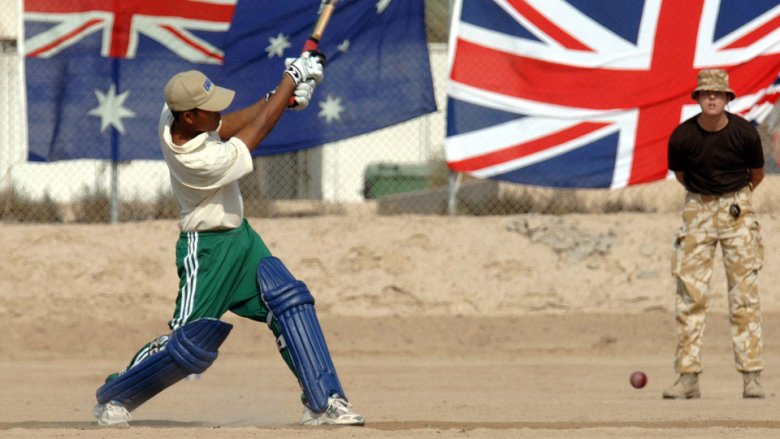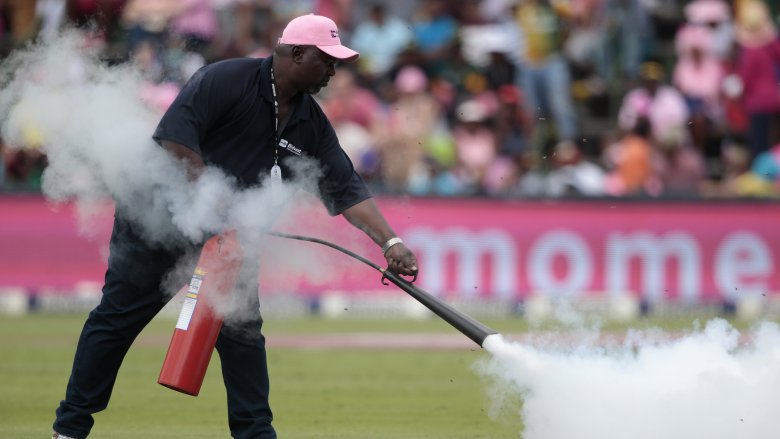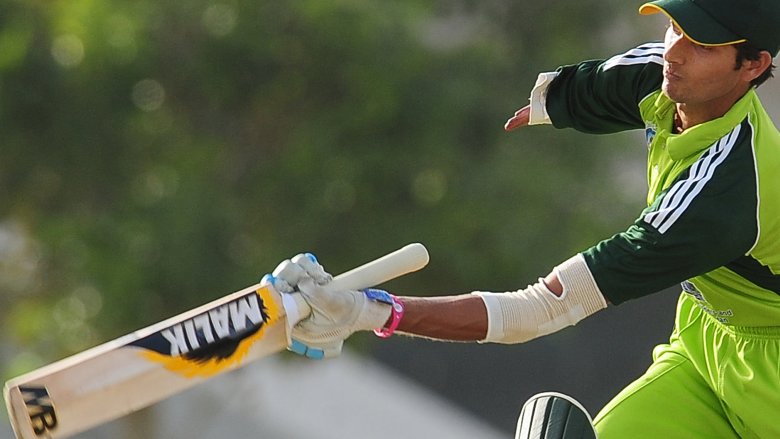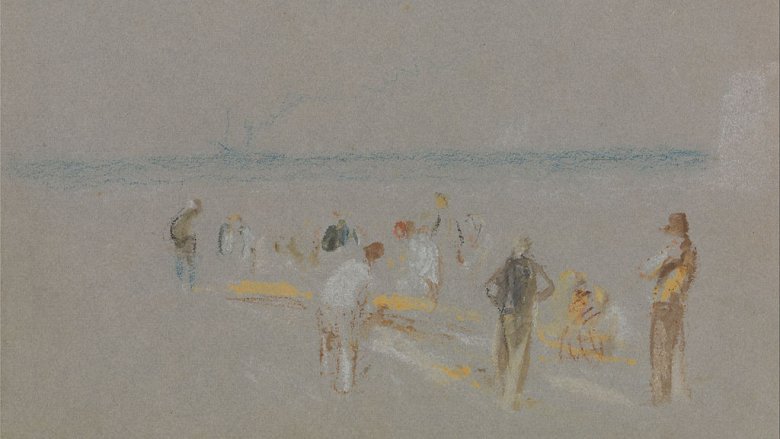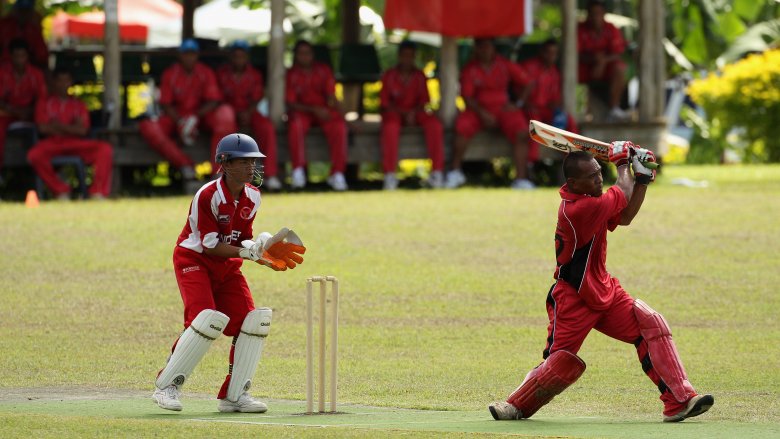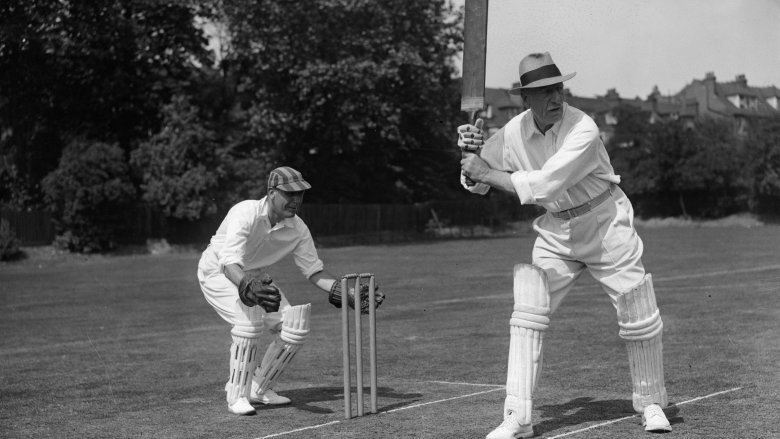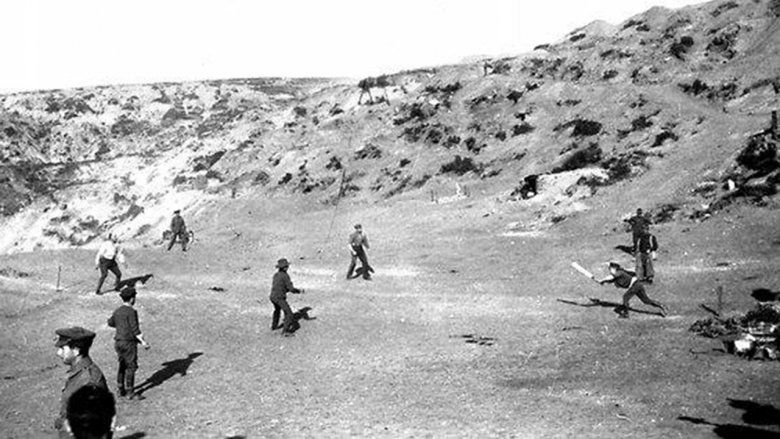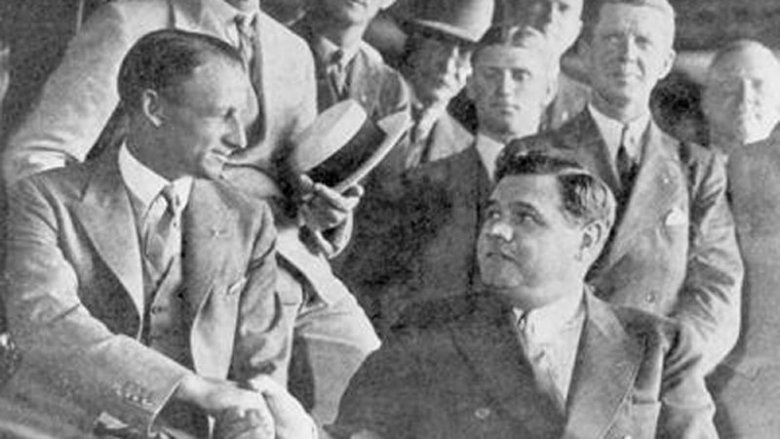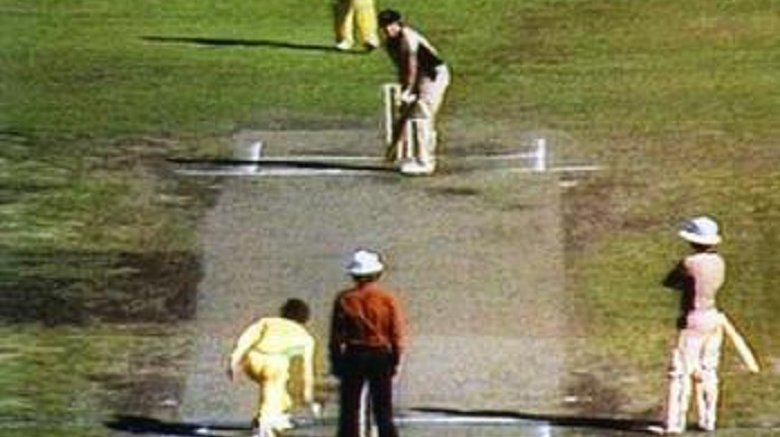Bizarre Things You Didn't Know About Cricket
To the uninitiated, cricket can seem both boring and confusing. Why does it take days to play? What kind of sport stops so the players can have tea? Isn't it just a less fun version of baseball? But cricket is one of the world's most popular sports. Basically, if England colonized a place, that country is now mad about cricket, with the exception, for some reason, of the United States.
But even if the rules seem unintelligible and the pace is too slow and the whole thing is extremely polite, cricket has actually managed to have some very interesting moments. While the excitement of some matches involves actually knowing what's going on, even a cricket novice can enjoy monkeys invading a pitch, or players running off the field because they desperately need to poop, or soldiers playing in the middle of war. And Babe Ruth gave cricket a try, so it can't be that boring.
Delhi Belly means players have more to worry about in India than the competition
The India team is very good at cricket, but for decades the top English players would refuse to travel there for matches. It wasn't that they were afraid of losing; it was that they always got sick.
According to the International Business Times, from the 1930s to the 1970s, "apprehensions over poor sanitation, unknown diseases and unhygienic food made India an unattractive destination for Englishmen" who played cricket. The food especially was a problem for guys accustomed to boring English fare. This resulted in something called "Delhi Belly," where they basically could not stop pooping, making playing very difficult. In order to get around it when he went to India and Pakistan with his team for the World Cup in 1996, England cricket legend Alec Stewart told the Guardian he brought 43 meals of chicken, mashed potatoes, and broccoli, which he ate every day for 43 days straight to avoid eating curry.
Nor has this problem gone away completely. In 2006, the Irish Independent reported that four members of the English team came down with Delhi Belly while playing in India. It's claimed that one year the players for an English women's team match were selected by seeing who could do a lap without vomiting or pooping themselves when the whole team was hit with the ailment. Australians also have this issue in India, with one player in 2017 causing confusion when he sprinted off the field in the middle of play, suddenly hit with the runs.
The Ashes in the Desert introduced rocket attacks to cricket
The Ashes is a cricket competition held between England and Australia at least once every two years since 1882. If you're into cricket, it's huge, and the rivalry between the two countries cannot be overstated. So in 2006, troops from both countries stationed in Iraq decided a little war wouldn't be enough to stop them honoring the Ashes spirit.
According to the BBC, it was all the idea of one British soldier, who even managed to organize five sponsors for the match, as well as official uniforms for each team. The Brits had to travel to the Australians' base by helicopter, but their arrival was delayed by a rocket attack just before they set off, with one soldier diving for cover in between bags of cricket equipment.
Once they arrived things didn't get any less "bizarre." The teams were playing in 110 degree Fahrenheit heat, on coconut matting and concrete, surrounded by desert. Balls kept getting stuck in sand or rocks. And at one point, a rocket had to be removed from the outfield. But hundreds of people turned out to watch and everyone seemed to have fun (pretty much guaranteed, since they had already delayed the game a week so they would have enough beer).
Just like in the regular Ashes that year, the "Ashes in the Desert" saw Australia emerge victorious. But the real winners were the two charities the match raised $14,000 for and the soldiers who got a bit of a distraction from the horrors of war.
The farce that resulted in the unofficial record of most runs scored on one ball
In the late 1800s, Australia was still considered the back of beyond to the seemingly more civilized people living in Britain, so this story has to be taken with a gigantic grain of salt. According to ESPN Cricinfo, on January 15, 1894, the Pall Mall Gazette published a story about a cricket game that went absurdly wrong.
A team from Victoria had come to play a local Western Australia team, but on the very first ball the batsman hit it into the fork of a tall tree, so of course the home team said it was a "lost ball." The umpire disagreed, however; he said that since the ball was still in sight it wasn't lost. This meant it was in play, and the batsmen started running. Meanwhile, the Western Australia team had to figure out how to get the ball back. First, they looked for an axe, but they couldn't find one so finally someone brought out a rifle. The batsmen kept running. It took a few attempts, but finally the ball was shot down. The one hit resulted in a score of 286. To put this in perspective, normally the max number of runs a player can score off one ball is six, with 10 the official record.
While the story made it into newspapers around the world, when it got to Australia, no one could find any evidence. It's almost certainly apocryphal, made up by the Gazette to show the Australians didn't know how to play "scientific cricket."
Bee invasions stop cricket matches all the time
There are billions of human cricket fans around the world, but these numbers are matched by the number of bees that apparently love cricket. The stinging insects cannot get enough of the sport. This is evidenced by how often huge swarms of bees descend on cricket matches, causing havoc.
According to Sportz Wiki, the first recorded "invasion of bees" that stopped play was in 1962. In 1981, a match had to be abandoned completely when six players and an umpire were stung. Bees saw players running for cover during major international matches in 2007 and 2008. USA Today reports in 2017 a bee invasion during a Sri Lanka-South Africa match necessitated the use of sticks, honey, a bucket of soda, fire extinguishers, and finally a beekeeper before play could resume. Bees stopped play temporarily during a match in Australia in 2018 and one in Zimbabwe in 2016. A swarm in India in 2019 not only paused play but saw five spectators taken to the hospital with injuries.
Other animals like cricket as well. The Telegraph says two monkeys invaded the pitch during an England-India game in 2012. In 1957, a hedgehog wandered onto the field during a championship match in England. When the players failed to shoo it away, the wicketkeeper, who wears big gloves, was tasked with removing the prickly animal. And during the 1982-83 Ashes, an Australian fan released a pig onto the outfield as comment on the rotund physiques of two England players.
One-armed versus one-legged cricket matches were a thing
Cricket was first played in the 1500s in England, but it wasn't until the 1700s that it became basically the national sport. It was so hugely popular that in 1796, someone decided to have a match between injured Navy veterans. One team would be made up of men each missing one arm, and the other of men each missing one leg. According to Cricket Country, the prize was 1,000 guineas, a huge amount of money at the time.
The rules had to be changed slightly to accommodate the sailors' handicaps, but the match was an enormous success. So many people wanted to get in to watch that play had to be suspended for three hours when a riot broke out. After two days, team One Leg emerged as the winners.
The Guardian reports that in 1848 there was a rematch of sorts (although with different players, since basically everyone from the original fixture had died). Thousands of people turned out to watch again and a band played throughout. Despite the previous game's result, people bet on the One Arm team to win. It wasn't your standard cricket, with a newspaper at the time writing "the general clumsiness of both parties at the game produced a match that was grotesque in the extreme." But everyone had fun. This time the One Arm team was victorious and after the match all the players joined up with the band, went to a pub, and got drunk together.
Playing cricket in a race against the sea
The English are an eccentric people, so of course they found a way to take cricket and make it really weird. For almost 200 years, they've had a tradition of playing the game on a surface that makes it almost impossible: a sandbar.
The Goodwin Sands are 4 miles off the Kent coast and sailors first started playing cricket there during low tide in 1824. The painter J.M.W. Turner did an undated sketch of cricket on the sands sometime before he died in 1851. ESPN Cricinfo says more matches were recorded in 1854 and 1919. Eventually, it became a tradition. Obviously, since the surface is wet sand, full of puddles, and only available for a couple hours at a time, it's impossible to play any real version of the game, but people still try. Or they did until 2003, when it was banned for being too dangerous, something a BBC crew proved three years later when they went out there to film a match anyway and had to be rescued when the tide came in.
But it's still legal to play cricket on the Bramble Bank sandbank off the Isle of Wight. This one only becomes visible for about an hour one day in August, and teams have been playing cricket on it annually since the early 1950s. Spectators have to watch from boats. Even though the winner is preordained (the two teams trade off, with the loser hosting dinner), players take the "bizarre" game very seriously, according to CNN.
The people of Tonga got a bit too obsessed with cricket
Wisden Cricketers' Almanack is known as "the Bible of Cricket." Published annually since 1864, the sport's reference book is a great source for weird stories about cricket from all over the globe. In the 1919 edition, according to the book Elk Stopped Play: And Other Tales from Wisden's 'Cricket Round the World', they eulogized the late King of Tonga, who had fallen in love with the game during his time at school in New Zealand.
On his return, the king had apparently introduced the island to the sport, but it went a bit too well. Soon everyone on Tonga was so obsessed with cricket the king had to pass a law saying they could only play one day a week, just so people didn't ignore important things like farming and risk a famine.
While the threat of starvation might be apocryphal, Tonga's love of cricket was real. The Guardian reports that William B. Churchwood, the British consul in Samoa in the 1880, wrote in his memoirs that he tried to introduce that island to cricket, but they had no interest for years. Then suddenly in 1884 people were "seized with a most frantic desire to fathom the mysteries of the game, and to become proficient in its practice." A visiting party of cricket-mad Tongans had come to Samoa and made fun of their hosts for not knowing how to play. The Samoans then asked the Brits to teach them so they could kick their island neighbor's butt in the future.
In Hollywood, cricket became embarrassingly over-the-top American
In the early days of Hollywood, British actors came to California to make it on the silver screen, but of course they still wanted to play their favorite game in their down time. So in 1932, the Hollywood Cricket Club was formed. Classically proper Englishmen like C. Aubrey Smith and David Niven were among the players, and author P.G. Wodehouse allegedly wrote up the minutes for the first meeting, according to the Telegraph. But over the next 65 years, things got decidedly too American.
Amazingly, cricket flourished in Hollywood, with teams popping up everywhere. However, by 2003, anyone who came to play cricket in Southern California from England was going to be "in for a bit of a shock." Instead of polite clapping you'd find "raucous shouts, foul language, and threats of violence." Fights broke out between players, and intimidating the umpire was considered a normal part of play.
One Brit said, "It is like a war. If you want to play cricket here you have to put up with hostility, aggression, antagonism and intimidation. The tactics are disgraceful and cheating is blatant. I've seen a bowler hurl the ball at the batsman's back and the batsman throw his bat at him. In one game a player pulled a stump out of the ground and chased another player with it."
Finally, the English had enough and celebrities including Sir Tim Rice, Eric Idle, and Mick Jagger worked actively to "reintroduce a more gentlemanly form of cricket to the state."
Cricket probably saved lives during a disastrous World War I campaign
Gallipoli was the most disastrous Allied campaign in World War I, and by December 1915 it was clear they needed to retreat from the beaches of Turkey after eight months' fighting. But this meant making plans to evacuate 105,000 troops without the enemy noticing. So in a show of "bravado," the ANZACs played cricket.
Australian and New Zealand troops (ANZACs) were going to leave the next day, but they knew they were under constant surveillance by Turkish forces, according to the Sydney Morning Herald. To save people's lives, they needed to make it seem like they were there for the long haul and like they were extremely sure of themselves. Taking time out to play cricket on the one flat area of beach they held was meant to show the Turks that the ANZACs weren't going anywhere.
It seems to have worked. While the game had to be called off because of enemy artillery fire (Cricket Australia says they only managed to play for a few minutes) it did give the enemy the wrong idea, and the ANZACs evacuated more than 20,000 troops over two nights with no casualties. It wasn't the only thing the Allies did to confuse the enemy, but it's the most memorable.
That's because the short match resulted in an iconic photo. The image of the soldiers playing is such a part of Antipodean cricket history that 86 years later the Australian Ashes team went to Gallipoli and recreated the picture.
Babe Ruth probably could have been a brilliant cricket player
The similarities between baseball and cricket have meant people good at one have often tried their hand at the other, just to see how well they do. But of course, the one person in history everyone would have wanted to see swinging a cricket bat was Babe Ruth. Fortunately, this actually happened.
According to the Guardian, the Australian player Don Bradman was a contemporary of Ruth's and possibly the greatest cricket batsman of all time. This made him to cricket what Ruth was to baseball, and the two legends met at Yankee Stadium once, in 1932 (pictured). Babe is said to have told Bradman, "I'll try this cricket business. Maybe it's my game." Three years later, when visiting London, he did.
At first, Dream Cricket says Ruth tried to adjust his batting stance to a standard cricket one, but it didn't work for him. Once he stood as if he were playing baseball, though, he was incredible. He hit everything bowled at him and managed to break a bat. He had so much fun that he stayed an extra hour and was late meeting his wife for lunch. The coach helping him told reporters, "In a fortnight, I could make one of the world's greatest batsmen out of him."
Ruth was more humble, saying it was easy to hit the ball with such a wide bat. He also said he would stick to baseball since he got paid an obscene amount, more than even the top cricketers.
The underarm bowling incident rocked cricket
While you probably never heard of it if you aren't really familiar with cricket, one of the most controversial sporting moments of all time took place during a game in 1981. It shouldn't have been a memorable match. According to ESPN Cricinfo, it was an "utterly forgettable one-day international," the third of a five-game series between Australia and New Zealand. They had each won a match already, so whoever won that one would have the advantage.
On the last ball, New Zealand had the chance to tie the score, but they needed a six, a cricket home run. To stop that from happening, the Australian captain instructed the bowler, Trevor Chappell (who also happened to be his brother), to throw the ball underhand, basically rolling it along the ground. This technique made it impossible for New Zealand to get the needed hit. While this was technically legal (somewhat like an intentional walk in baseball), the cricket world went insane.
One former player said the throw had killed one-day cricket, and the Sydney Morning Herald reported another burst into tears talking about the irreparable damage it did. It made front-page news. People jammed switchboards when they called to complain about what happened in huge numbers. Both the New Zealand and Australian prime ministers spoke out against the throw, with the Kiwi calling it a "disgusting incident" and an "act of true cowardice." And cricket's international governing body changed the rules, making underarm deliveries illegal in one-day matches.
Thirty-seven years later Chappell said the event still "haunted" him.


